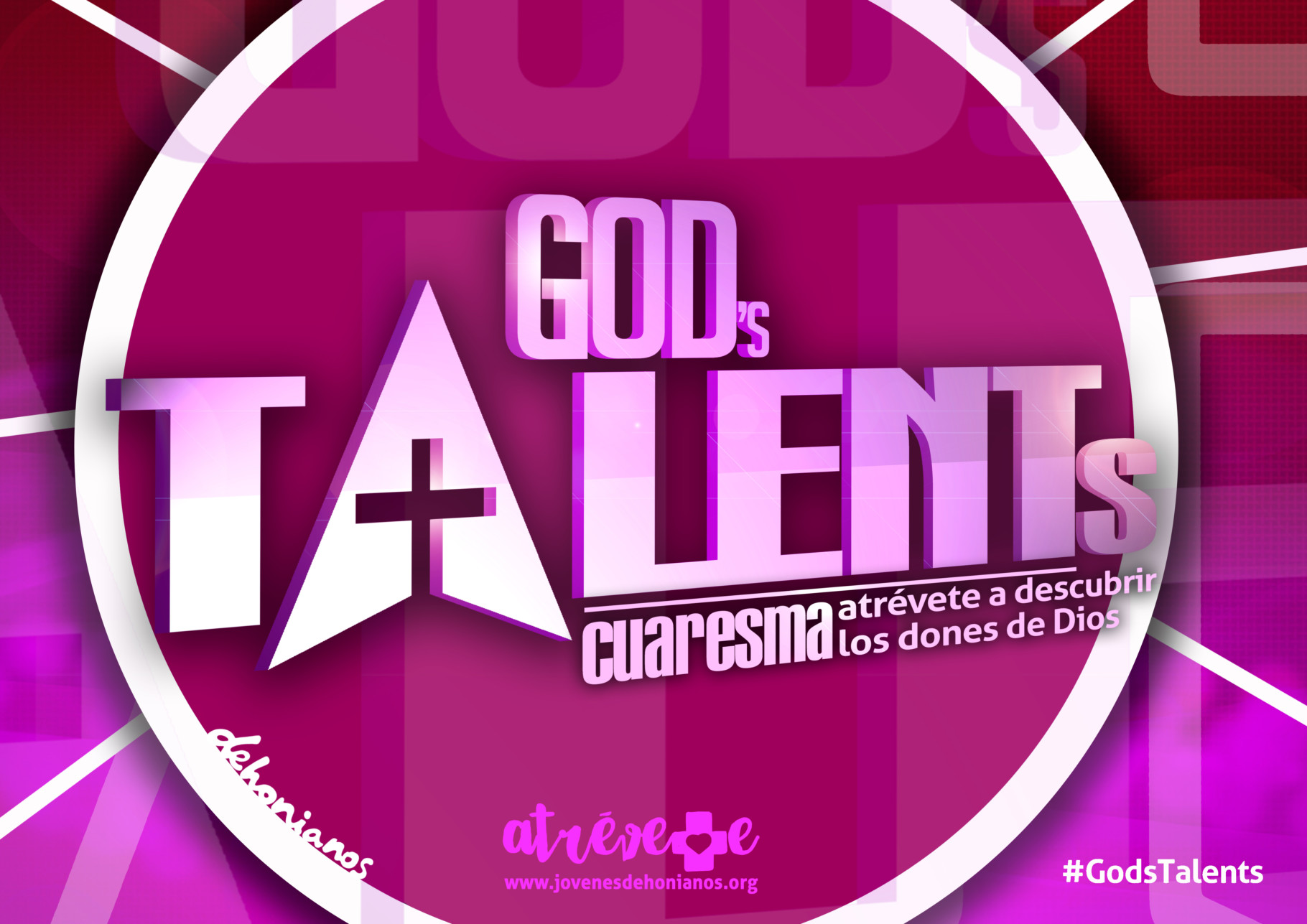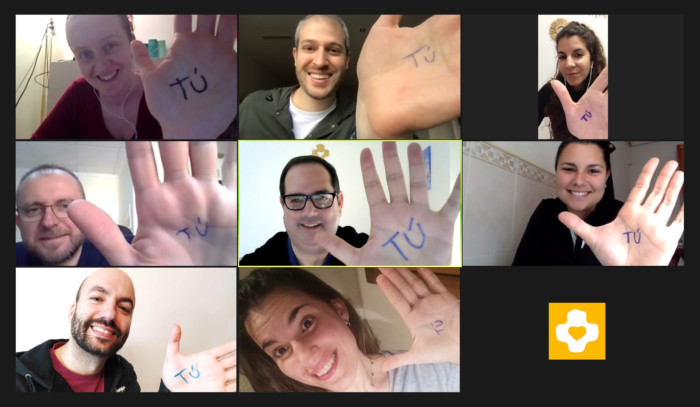Ángel Alindado, a religious of the Priests of the Sacred Heart of Jesus (known in Spain as Reparadores or Dehonianos), is the Coordinator of the Delegation of Vocation Ministry. In the Delegation, he works with José Antonio Casalé, also a Dehonian religious who is in charge of MyMission International Volunteers, and Gracia Granados, who is responsible for Dehonian Youth and in pastoral work with young people. At least three times a year, the Youth Pastoral Team meets with the Delegation to design campaigns, annual slogans and different activities in which young Dehonians in Spain participate.
This June, in Madrid, they will receive the Charism Award for youth and vocation ministry from Confer (the Spanish Conference of Religious) for “their creative and current publicity campaigns with the aim of promoting the knowledge and promotion of Religious Life in our society”. A “totally unexpected” award, in the words of Ángel Alindado, but “a precious recognition to a way of working, to the shared mission, and to the creative audacity”.
How do these campaigns come about? What is the creative process of these campaigns like?
Perhaps, before answering the question, it is good to explain where the ideas arise and the reason for them. For many years now, when it comes to proposing common activities for the different pastoral works we have, the youth and vocation ministry has been working with a motto. At the beginning it was used, above all, for the beginning of the school year and activities such as the Youth Meeting in Salamanca (where about 150 young people, teenagers, from our schools and parishes usually gather). Over the years these slogans were adopted as annual mottos and have become a wonderful opportunity to update part of our spirituality, specific aspects of our charism and mission, with an attractive and even provocative language.
We have achieved that almost all our works, especially the schools, walk hand in hand and offer a common base of themes, educational and pastoral proposals, reflection, activities, etc. linked to the same Dehonian theme, motto and image. In addition to this, we “adapt” them (we work on a specific part of the theme) during the strong liturgical seasons of Advent-Christmas and Lent-Easter, where we have always felt more “free” when it comes to creating, proposing, and attracting attention.
 Along with this aspect it is necessary to mention where many of the slogans and pastoral campaigns in the strong times mentioned above arise. For some years now (I think I recall about 12-15 years… 10 in a more structured way) a group of young people between 20 and 35 years old have been collaborating with the religious who work in the Delegation of Vocational Pastoral (which also includes the youth pastoral) and have an active part in activities and shared spaces and ways of transmitting the Gospel that had an impact on them or left a mark. The group has been changing in its components, with some joining and others leaving, so there is always freshness. It is in the meetings throughout the year, 3 at least, where the spark of creativity, audacity and a point of healthy “madness” to recreate the way of transmitting the Gospel and captivating spiritual experience of Father Leo Dehon, our founder. The creativity and originality of the campaigns is due to them and to the good design skills of some of us who are part of the Dehonian Youth Team. Behind a slogan, as you can imagine, there is not only a good phrase or a good image: there is plenty, plenty of the Word of God, plenty of reflection on the values we want to transmit and also plenty of prayer. In practice, some of our meetings are not different from a brainstorming session or a briefing session of any advertising company. In some moments we take inspiration from well-known and recognizable brands, series, TV shows, or movies, we give them a twist, change slogans, take advantage of those messages… You don’t know the amount of crazy things that sometimes come up, like the campaign we did for an Advent using the “I am not a fool” of a well-known electronics store to which we added a phrase from St. Paul to Timothy, “I know whom I have trusted”, the one in which we talked about the talents that God gives us, God’s Talents, or the last one in which we reflected on the newness of God in our lives, taking advantage of the fact that another chain, this time a DIY store, was proposing to let “the new” into our homes. Some of our proposals leave those who see them a little bit off-put by the aesthetics, by the message and by the way we know how to give a twist to the advertising messages of our world.
Along with this aspect it is necessary to mention where many of the slogans and pastoral campaigns in the strong times mentioned above arise. For some years now (I think I recall about 12-15 years… 10 in a more structured way) a group of young people between 20 and 35 years old have been collaborating with the religious who work in the Delegation of Vocational Pastoral (which also includes the youth pastoral) and have an active part in activities and shared spaces and ways of transmitting the Gospel that had an impact on them or left a mark. The group has been changing in its components, with some joining and others leaving, so there is always freshness. It is in the meetings throughout the year, 3 at least, where the spark of creativity, audacity and a point of healthy “madness” to recreate the way of transmitting the Gospel and captivating spiritual experience of Father Leo Dehon, our founder. The creativity and originality of the campaigns is due to them and to the good design skills of some of us who are part of the Dehonian Youth Team. Behind a slogan, as you can imagine, there is not only a good phrase or a good image: there is plenty, plenty of the Word of God, plenty of reflection on the values we want to transmit and also plenty of prayer. In practice, some of our meetings are not different from a brainstorming session or a briefing session of any advertising company. In some moments we take inspiration from well-known and recognizable brands, series, TV shows, or movies, we give them a twist, change slogans, take advantage of those messages… You don’t know the amount of crazy things that sometimes come up, like the campaign we did for an Advent using the “I am not a fool” of a well-known electronics store to which we added a phrase from St. Paul to Timothy, “I know whom I have trusted”, the one in which we talked about the talents that God gives us, God’s Talents, or the last one in which we reflected on the newness of God in our lives, taking advantage of the fact that another chain, this time a DIY store, was proposing to let “the new” into our homes. Some of our proposals leave those who see them a little bit off-put by the aesthetics, by the message and by the way we know how to give a twist to the advertising messages of our world.
Are they all “round”? Of course not… we are always evaluating and seeing where we fail, where we get it right. But some do make an impact. Impact that we use to then try to open our hearts to the real message that lies at the heart of each image and slogan.
The surprise came, and comes, when other religious congregations, both inside and outside Spain, request your materials and dynamics. Or when those responsible for pastoral ministry in different dioceses use our posters and pastoral proposals, there are parishes that label us, congratulate us… We offer it for “free”, because “free” we have received it. And “free” comes from “grace, gift”. God’s gifts are to be shared.
Have you detected a lack of response to traditional communication? How can these messages be adapted without detracting from the word of God?
Our Congregation is relatively young: it was born in 19th century France and took its first steps at the end of the 19th and beginning of the 20th century. From the beginning it was a very international and missionary Congregation. From there, and from Father Dehon’s attempt and determination to translate the language of the Church to the people of it’s time, I believe that part of the interest of many Dehonians to translate and explore new languages for a message, that of the Gospel, ancient and always current, is born.
 Today our world, at least in the field of communication, is attracted by powerful ideas, powerful images, conveyed in a powerful way and with few words. We see this in the world of marketing and advertising. In recent years, moreover, we have seen that it is not only those in charge of selling a product who sells the product. Sometimes they don’t even care about selling you the features of the product. Their interest is focused on you capturing the emotions and the feelings that this or that product causes in you. They don’t sell cars, perfumes, or food: they sell life experiences… And it turns out that the Church not only has the best product, not only does it have the best message; It doesn’t just have the best values. We can offer experiences and “The Experience”, with capital letters. And that, I think, is where we often come in, with our simple and sometimes daring campaigns: we provoke and focus, on many occasions, on the experience that a young person can have or what God can bring about in their lives… Once the young person grasps that, it’s time for the characteristics of the car I want to sell you, the benefits of drinking Coca-Cola or the impact you are going to leave on others by using this or that cologne. That is to say, the moment to fill with content of faith, which is not just a feeling, but has a lot of rationale, to see the possibilities and the goodness of offering your life, despite the difficulties, and how you are going to leave an indelible mark in our world.
Today our world, at least in the field of communication, is attracted by powerful ideas, powerful images, conveyed in a powerful way and with few words. We see this in the world of marketing and advertising. In recent years, moreover, we have seen that it is not only those in charge of selling a product who sells the product. Sometimes they don’t even care about selling you the features of the product. Their interest is focused on you capturing the emotions and the feelings that this or that product causes in you. They don’t sell cars, perfumes, or food: they sell life experiences… And it turns out that the Church not only has the best product, not only does it have the best message; It doesn’t just have the best values. We can offer experiences and “The Experience”, with capital letters. And that, I think, is where we often come in, with our simple and sometimes daring campaigns: we provoke and focus, on many occasions, on the experience that a young person can have or what God can bring about in their lives… Once the young person grasps that, it’s time for the characteristics of the car I want to sell you, the benefits of drinking Coca-Cola or the impact you are going to leave on others by using this or that cologne. That is to say, the moment to fill with content of faith, which is not just a feeling, but has a lot of rationale, to see the possibilities and the goodness of offering your life, despite the difficulties, and how you are going to leave an indelible mark in our world.
I believe that in the Church there is no “traditional” communication. The Christians of each epoch have tried to make their own the means available to them. This is the origin of everything from the great books of Christian apologetics, to the great Gothic cathedrals, to the covers of Romanesque temples. And in all these expressions we find an attempt to communicate the same message with new means. Today, together with architecture, painting and music, ours are called design, media and social networks, internet, advertising, image… The same message, as old as it is groundbreaking, but with the means of our time. As an example, I like to say that our posters and campaigns are, as they are called in homiletics, the captatio benevolentiae, that is to say, the way to capture the attention of the faithful and then “place” in the homily the messages of the Gospel and the experience of the Church. Basically, we are not inventing anything, are we?
What is the Church’s unfinished business in the area of communication?
Perhaps finding the right balance between the greatness of the Gospel message and how to create the necessary impact to capture the attention of our world. Today a young person (and an adult for that matter) is inundated with thousands of images and messages every hour. Our challenge is to make the first proclamation of the Gospel meaningful enough to fill life with meaning once the door is opened.
What do you think of the milestone of the Pope having a Twitter account? Should the Church follow all social media trends?
The Pope’s move was not only a Twitter account. It was accompanied by a change of strategy at the communicative level. It is true that Benedict XVI in 2012, when he allowed the papacy to “enter” this social network, took a firm step, thus recognizing that the “digital” is not at odds with the ancient and groundbreaking message of which I spoke earlier. Francis has spoken of the “digital continent” on some occasions, as a space to evangelize. And we are all involved in this task… some with more success than others, with more or less expertise in presenting ourselves and the Gospel in the networks… Trends? I am a bit more conservative here: those that can serve the Message, great… Others that only serve for quick recognition, to have more “likes” and gain followers… well, I would say with prudence and head. That said, I know priests, religious men and women, lay people committed to the proclamation of the Gospel who evangelize from their social networks, cooking for well-known people and who have something to tell, singing and choreographing for TikTok, playing PlayStation and sharing their games on Youtube, doing impossible interviews, rubbing shoulders with well-known Youtubers… And they all have a clear reason for being there and how their life and their success are not for themselves, but are for God.
After the success of these campaigns, what are your next steps?
The Charism Award for Youth and Vocation Ministry, was totally unexpected, is nonetheless a precious recognition of good work and also of a certain repercussion in the ecclesial sphere. More than an award that recognizes success, it is an award to a way of doing things, to the greatness demonstrated in the shared mission, to the creative audacity and to the trajectory of all these years. The next steps will be marked by the context in which we find ourselves and the challenges of transmitting the Gospel. Hopefully, and there is a lot of challenge here, we can continue to find the right channels to move from the initial impact and the first message to a deeper reflection that ends up provoking a change in the young people, in a life option, in their greater union with Christ….





